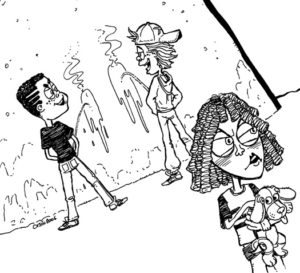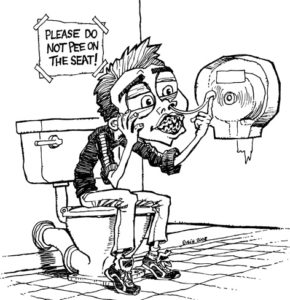I recently read a blog post by Clara Bennathan on the effect porn is having on teenagers’ expectations of sex – especially boys’ expectations. The article is a disturbing, but not very surprising, read and raises a related and difficult issue for children’s book publishing in general . . . and boys’ attitudes in particular.
I’m not one to shy away from violence in my books, partly because it adds drama to a story, but also because it is one of many different challenges to the protagonists that help create perspective. By imagining fictional lives and worlds that are very different from our own, we can look at some of the uglier aspects of life, and make judgements about them, without having to experience them. And I know boys like violence, so that’s another incentive to have it in stories, because I want boys as well as girls to read and I especially want them to read my stories. But I think there’s a responsibility here too. The more realistic the violence in my stories, the more serious I make the consequences for the characters – something my readers are unlikely to see in the violent games they play, and often in the films they watch. It’s one of the advantages of a book. You have the time and depth of field to show consequence.
Those consequences are key – and they can be handled in books better than anywhere else, because the reader is already halfway there, investing their own imagination in the creation of the story. They have created an empathic link of their own.
But in the real world, violence is something most people avoid at all costs and it’s certainly something we hope our children don’t experience firsthand. Sex, on the other hand, is something we hope they’ll get round to once they’re old enough. And yet, as we all know, anything that might have anything to do with sex is a far more delicate subject to broach in children’s literature – much more so even than violence.
This is mostly because any discussion of sex in relation to the word ‘children’, raises the ugly head of paedophilia. Something else that threatens huge damage from the untamed jungle that is the web, and yet – like teenage access to violent porn – the attempts to combat it always seem to be struggling to catch up with the horrific reality of it.
Anyway . . . ours is a strange industry, where it is far more acceptable to show someone killing someone else in a children’s book than to show two adults fondling each other.
Which is odd when you ask yourself, which of these two activities do we want kids indulging in when they’re older?
Which do we need them to be knowledgeable about if they’re to have healthy relationships and lead happy lives, and to understand the concept of consent? How are we to do something as fundamental as propagating our species without knowing how best to do it? And it is these earthy fundamentals that appeal to boys . . .
Well, and girls too.
Why are we so reluctant to show naked people in young children’s books?
Why is it we can’t show body parts the children have themselves and see every day in family life? Writers and illustrators don’t even try most of the time, because we know what the answer will be. I once had a disagreement with an editor over a scene in an illustrated book for confident readers, where two boys have a pissing contest – something boys do from the point where they can stand up and aim (or not).  Both boys had their clothes on in the illustration, there were no willies in view and there was a girl with a suitably disgusted look on her face to provide some balance. The editor was an open-minded, very liberal and easy-going person, but her job demanded that she worry about the reactions of parents and teachers. And their expectations of what one should, or should not, see in a children’s book. She was just representing the views of the publisher, and the publisher was effectively bound by the conventions of the industry.
Both boys had their clothes on in the illustration, there were no willies in view and there was a girl with a suitably disgusted look on her face to provide some balance. The editor was an open-minded, very liberal and easy-going person, but her job demanded that she worry about the reactions of parents and teachers. And their expectations of what one should, or should not, see in a children’s book. She was just representing the views of the publisher, and the publisher was effectively bound by the conventions of the industry.
In the end, the scene stayed in (as did the illustration), but it left me feeling frustrated about those conventions, and what they do and do not allow.
We really need to ask ourselves when the portrayal of our bodies, and more especially our bodily fluids and where they come out, became such a distasteful subject. Surely, being able to talk openly and frankly about these things is vital for our health and well-being. Instead, discussion about our bodily parts – and what springs from them – is considered rude, disgusting and many younger children seem to be of the opinion that the anatomical terms for these things are no different from the swearwords that have been derived from them. There are even adults who think the same way.
I’ll be doing another post sometime soon on swearing.
We have made this, most important of subjects, a dirty joke, a taboo subject and in doing so, have made it almost impossible to broach with children in a reasonable and mature way before they actually start finding out about it for themselves. And what’s worse, is we’ve effectively forced them to go online, hoping to find out what the adult world refuses to tell them. These things are either dealt with as a subject of toilet humour in our entertainment, or cold biology in education or as ‘social issues’. We rarely treat them as if they’re just normal.
I can really only speak from a boy’s point of view here, but then as far as the teenage obsession with porn is concerned, boys are the real problem. Speaking as someone who, as a young man, once believed nothing in his life could ever be more important than sex, I can fully understand the mind-altering urges lads get and how they can lead them astray. I do find most porn distasteful, not because I don’t like watching sex – I absolutely do – but because of the way the porn industry treats human beings in general and women in particular. And their stories are usually rubbish, which really breaks the spell. Thankfully, my imagination was better than most of the photos or films I saw as a young man (and still is).
But back when I was a teenager, there was only so much a boy in Ireland could access. Things have changed. Now the really hardcore stuff is out there, it’s viral, it can be got for free and it’s far more extreme and abusive than anything my generation would have been likely to encounter. And what’s most troubling, is the attitude towards women and the violence that is associated with this stuff. And some boys are becoming convinced that this is normal – and are now trying to get girls to reproduce this crap and even record it for themselves.
But what has all this got to do with children’s books? I mean . . . come on, Oisin. I mean, books that aren’t aimed at teenagers. I mean, books for younger kids? Really? It’s not like we’re going to start putting adult sex scenes in those, is it?
Well, no. For the simple reason that it’d be really hard to get right and it would probably be commercial suicide.
But . . . we all know the average boy becomes fascinated with his penis long before he knows anything about sex. He has his first erection long before he knows what he’s supposed to do with it (it is, quite frankly, a bizarre experience when you become aware of it). And given that his body is all there is of him in this world, it’s only natural that it fascinates him.  Saliva, sweat, blood, urine, faeces, flatulence, mucus, vomit, semen – whether it disgusts you or not, this is the stuff of life. It’s what we’re made of. We are hardwired to react to each of these things in a different way, because our very survival may depend on it. The most complex part of writing – understanding and provoking emotions – starts with the basics. Biology. To get anyone reading, a writer must provide something that sparks their interest, and like the majority of us when we were young, the average boy is most interested in himself.
Saliva, sweat, blood, urine, faeces, flatulence, mucus, vomit, semen – whether it disgusts you or not, this is the stuff of life. It’s what we’re made of. We are hardwired to react to each of these things in a different way, because our very survival may depend on it. The most complex part of writing – understanding and provoking emotions – starts with the basics. Biology. To get anyone reading, a writer must provide something that sparks their interest, and like the majority of us when we were young, the average boy is most interested in himself.
And the parts of himself that he is most fascinated by are the tangible, physical bits. The things he can see, hear, feel, taste and smell. The things that provoke the strongest emotions for him, are those that stimulate or threaten these parts of him, and they are the base emotions: disgust, anger, fear, satisfying a physical need, or sexual arousal. So the stories boys seek out most often are those that appeal to their base instincts – at least at the start. And the fact that these things are often considered disgusting or unsuitable or even immoral just makes stories about them funnier, more interesting and more exciting.
But it also convinces children that these things are socially unacceptable, so if they’re curious about finding out more, they’re going to have to do it in secret. That’s where the real problem lies.
Unfortunately, in my opinion, in the children’s book industry, we don’t acknowledge children’s earthy appetites enough. When we’re not ignoring the subject outright, we treat it with distaste and disgust, we don’t do enough to sate it and what little we do, we do too late. We are not honest with our children. In a sincere attempt to protect their innocence, we make them ashamed of their bodies. We leave them with too narrow a perspective and too uninformed, ill-equipped to deal with these issues when they begin exploring for themselves.
In Ireland, I believe the pledge Catholics take at their confirmation to not drink alcohol until they’re eighteen has done untold damage, because it encourages secrecy. Teenagers don’t avoid drinking, they just avoid drinking in front of adults who could promote a mature attitude to it. As a result, they plough in unprepared, they binge drink and that’s where the real damage is done.
We’ve done the same thing with our attitudes to our bodies. Long before they strike out on their own, kids have started contrasting the normal bodies they see around them – the ones they’ve been taught not to look at, not to talk about – with the bodies they see displayed in magazines on racks in every newsagent and on millions of websites.
And they start learning about sex on the web, because what little they’re being told – often in school – is factual and it’s done in a class situation where they can’t express themselves as openly as they’d like. And frankly, it’s just not entertaining enough to engage them emotionally.
Schools do their best, but by the time they start teaching this stuff, children’s attitudes to their bodies have been cemented by the awkwardness of the grown-ups they know, who are reluctant to discuss it, the frustrating lack of it in children’s entertainment, and the saturation in the wider media of images created by grown-ups who neither know nor care who’s looking at the stuff.
We have, in effect, turned over the sexual education of our children to disinterested strangers whose motives vary from the fairly harmless to the downright abhorrent.
I’m not suggesting that we need to start loading children’s books with graphic sex or try to compete with what’s on the web. I just think that the depiction of the human body in children’s books should be kept in step with children’s knowledge of their own bodies and those around them. They need to see images of ordinary, flawed human bodies and learn to appreciate them for what they are. And they need to see it in a normal context, without making it a Carry On-style joke, or a serious social issue. Children need to develop emotional maturity about nakedness and body parts in preparation for the complicated demands that will be placed on them as they become sexually mature.
The other, darker side of the issue, the treatment of women in porn, is obviously a harder one to address in children’s books – and books already promote positive attitudes between different genders, because it’s something the industry is very conscious of. But if we can encourage boys to read more, empathy will be the happy by-product and it’s the only thing that will convince them how awful some of the stuff that’s out there really is.
And as teenagers do become sexually mature, they need to have some idea of where to look to find easy, well thought-out and unembarrassing information on sex, on the web or elsewhere – how to do it right and have fun in the process.
But it all starts with the body and how it’s portrayed. And the earliest and best place to start, is in books.

Reminds me of the quote by George RR Martin – “I can describe an axe entering a human skull in great explicit detail and no one will blink twice at it. I provide a similar description, just as detailed, of a penis entering a vagina, and I get letters about it and people swearing off. To my mind this is kind of frustrating, it’s madness. Ultimately, in the history of [the] world, penises entering vaginas have given a lot of people a lot of pleasure; axes entering skulls, well, not so much.”
Thanks for this, Oisín. Hope you’re starting a revolution.
As for porn being badly written, I totally agree. I would pay to see a porn movie written by you!
James
Don’t think it hasn’t crossed my mind, James.
Well done, I feel the issue if violence without any consequences is becoming more and more common within children’s literature.
On the issue of honest, flaws and all sexual relationships within books- well I agree totally but get more flak about this from parents and fellow educators than anything else.
Recently I had to pull a book that discussed a girls first period and sexual thoughts- sensitively covered- even though I’m seeing that book about children killing children (you know the one!) being read by 7 year olds with parental consent. Yet often the only sex education these kids get is provided by a church based organisation. I have challenged them as to why they don’t cover same sex relations, to be told parents don’t want it.
Can’t wait for more open dialogue about these issues.
Thanks Jane. I know it’s hard for professionals dealing with reactionary parents – or other professionals – to make changes, which is why I think it may be up to the publishing industry to start steering things round. It could just be simpler things, like being a bit more frank and open in younger kids’ books, before sex becomes an issue, so that when it does, readers are a bit more comfortable when it comes to basic stuff like referring to body parts. Sad to say, it’s the kind of thing that has to become so popular among kids that adults will give in and go with it, which means trying to bypass adult defensiveness. Always a big challenge for children’s publishers.